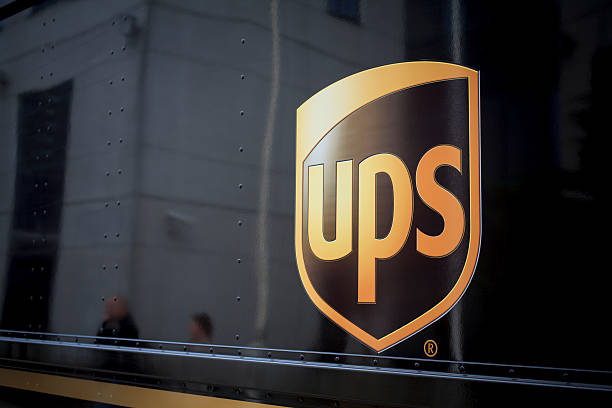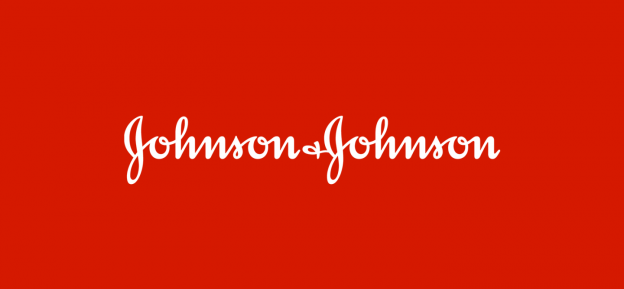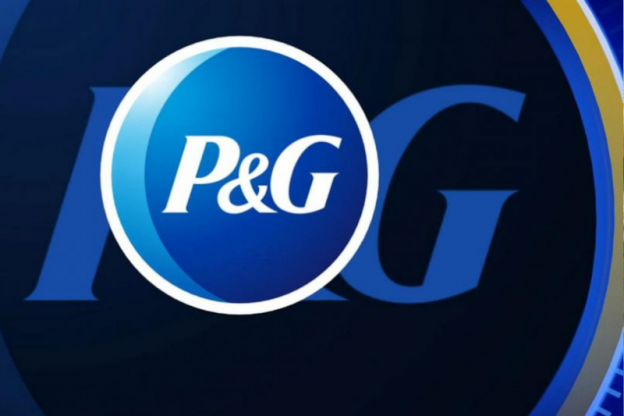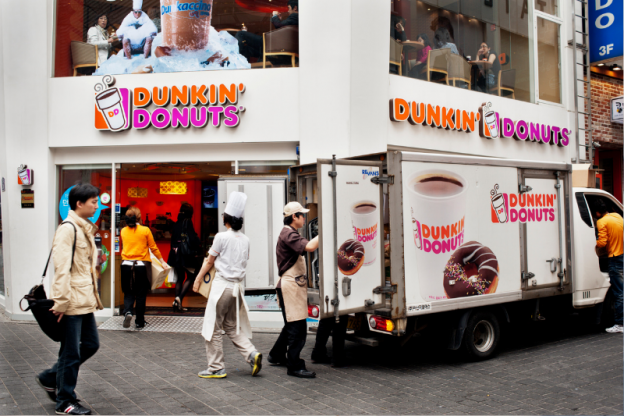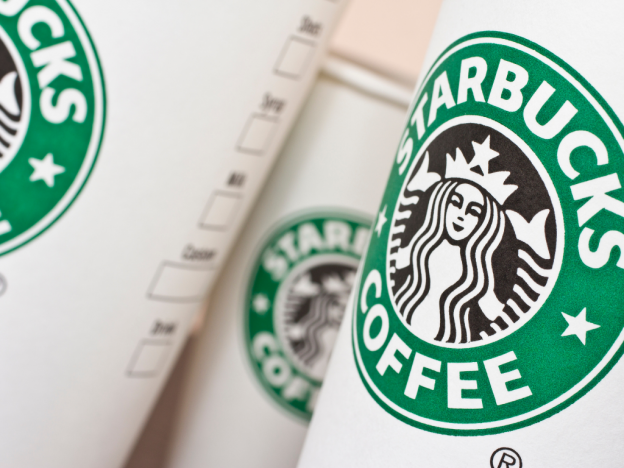This is a free Amazon SWOT analysis available for all students. You should use it only as a reference.
Company Details
| CEO: | Andy Jassy (Jul 5, 2021–) |
| CFO: | Brian T. Olsavsky |
| Founder: | Jeff Bezos |
| Founded: | July 5, 1994, Bellevue, Washington, United States |
| Headquarters: | Seattle, Washington, United States |
| Number of employees: | 1,608,000 (2021) |
| Revenue: | 386.1 billion USD (2020) |
| Subsidiaries: | Whole Foods Market, Audible, Zappos, Shopbop |
With the advent of the internet, everything has seen a drastic change, from what we wear and eat to how we think. There are big and influential companies behind that change. Through their business models as well as products and services, they have not only managed to maximize their profits but also changed the way we live.
Amazon used to be a famous river. Now, it is the world’s leading online retailer with over 300 million active customers and over 200 million Prime subscribers to its products and services. The brand has become synonymous with a market leader in the retail business, digital streaming, and much more.
Even though it has come a long way from being a meager online book store to a retail giant, it had its challenges and trials.
In this article, we will take a comprehensive look at the strengths, weaknesses, opportunities, and threats that Amazon faces as one of the biggest online retail businesses.
Do you need a custom SWOT Analysis for your research or presentation? We can certainly help you with that! Our team of professionals can conduct a better and more accurate custom-made SWOT Analysis for your needs. Connect today!
SWOT Analysis of Amazon
SWOT Analysis is a great tool that managers can utilize to get a clear view of their company’s advantages and disadvantages. It takes time and effort to gather unbiased data regarding a company’s or an industry’s internal and external positives and negatives, but it provides amazing insights that may be hard to understand without it.
A SWOT Analysis is visually represented in a square box with four equal quadrants. Each quadrant holds data according to its designation. Mostly, researchers start from strengths and weaknesses, internal factors, to opportunities and threats, which are external factors.
Amazon’s Internal Factors
Let’s start the SWOT Analysis with the strengths and weaknesses of Amazon that makes it a market leader.
💪 Strengths
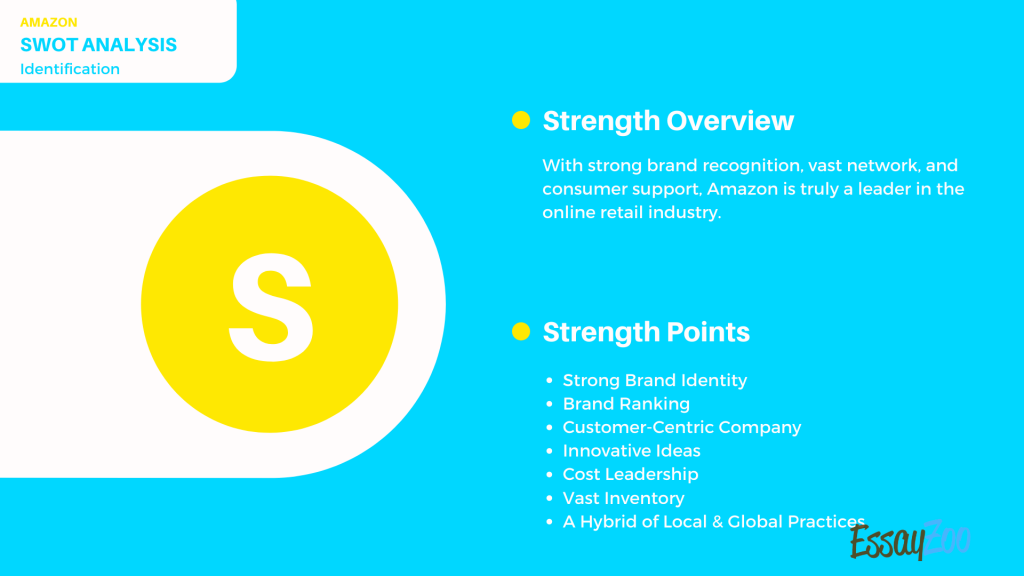
Following are some of the aspects that give Amazon a comparative advantage over its competitors:
Strong Brand Identity
As one of the largest e-commerce brands in the world, the Amazon brand name carries immense value and prestige. In some cases, it is the second name of online shopping.
Brand Ranking
Some estimates place Amazon in second place among brands rankings. It is between Apple and Google with an estimated brand value of around $250 Billion.
Customer-Centric Company
Amazon is a customer-oriented or customer-first brand. It provides a platform for sellers to sell affordable, everyday-use items to the public. This has immensely augmented its image as a people’s brand.
Innovative Ideas & Products
Even though Amazon is a retail business, it has never been shied away from testing and implementing new and exciting products and services. The highlights in this regard are drone delivery systems, products like Alexa, and so on.
Cost Leadership
Another thing that sets Amazon apart is its rigorous cost control methods. Instead of maintaining warehouses and depots on its own, Amazon gets suppliers and vendors on board. This allows effective cost-cutting with efficient workflow.
Vast Inventory
When it comes to Amazon, there is a running joke that a customer can purchase from a needle to a live elephant from there. This is a testament to the vast inventory selection that the company maintains.
A Hybrid of Local & Global Practices
Amazon is a local brand but it does not capture new markets as such. Instead, it introduces its products and services through local supply chain companies to minimize the foreign element. It also helps Amazon in identifying the needs of local people to adjust its products and services accordingly.
🤒 Weaknesses
Here is a rundown of some of the weaknesses that Amazon faces internally:
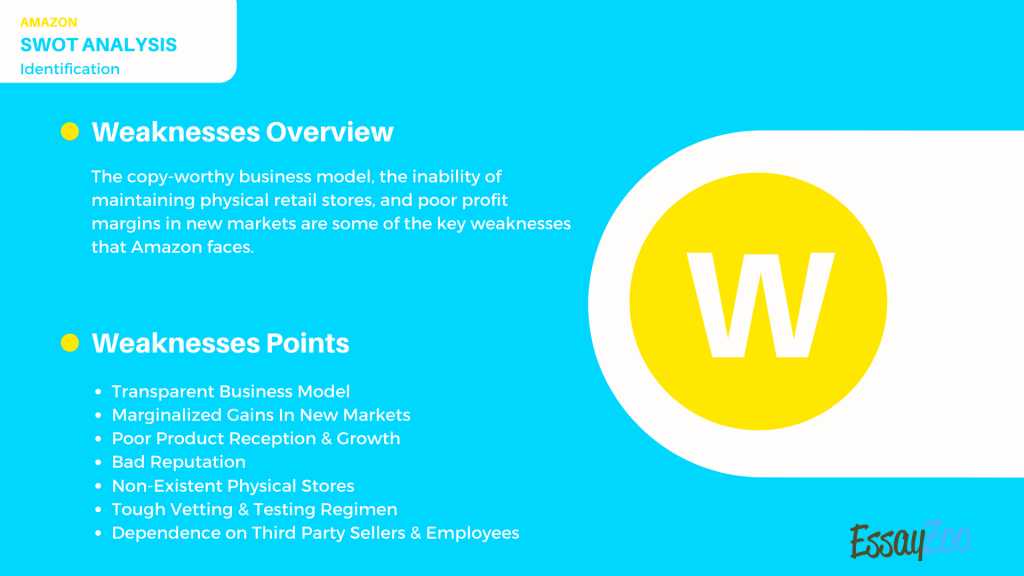
Transparent Business Model
As mentioned in the introduction, retail businesses have become quite a norm due to ease of entrance and immense growth potential. That’s why start-ups and established rival firms can easily copy business model and operations from Amazon which result in a reduction in profits.
Marginalized Gains In New Markets
To capture new markets, companies give incentives to customers. In the case of Amazon, capturing new markets often come with a cost – marginalizing profits through online retailer selling. For instance, in India, Amazon’s free shipping offers led to losses and poor cash inflow.
Poor Product Reception & Growth
From Fire Phone to the Kindle tablet, many Amazon products failed to impress the market and didn’t meet the expectations of the audience. In the long run, some of Amazon’s products and services, including digital streaming platforms, failed to adapt to the economies of scale.
Bad Reputation
Amazon has been subjected to a lot of controversies in the last few years. Tax avoidance issues in the UK and Japan brought a bad name to the brand. In addition to this, reports about poor employees treatment and unfair use of third-party data have changed the company’s image for the worse.
Tough Vetting & Testing Regimen
With the rise in the number of products and goods being sold at Amazon, it is hard for the company to test and vet potential hazardous materials. In addition to this, controversies such as the EPA directive to remove pesticides and other such products from the platform brought a bad name to the company.
Dependence On Third Party Sellers & Employees
Since it is a retail store with virtually no physical presence, Amazon has heavily relied upon its sellers and coordination of employees for successful operations. In case of strikes and disagreement with either employees or third party sellers could lead to termination of operations. A recent example is Germany where Amazon employees protested against poor working conditions and stopped operations in six distribution centers.
Amazon’s External Factors
Now, let’s explore the opportunities and threats that Amazon is facing today.
🤑 Opportunities
The list of opportunities that Amazon can cash to maximize its market footprint and profits are as follows:
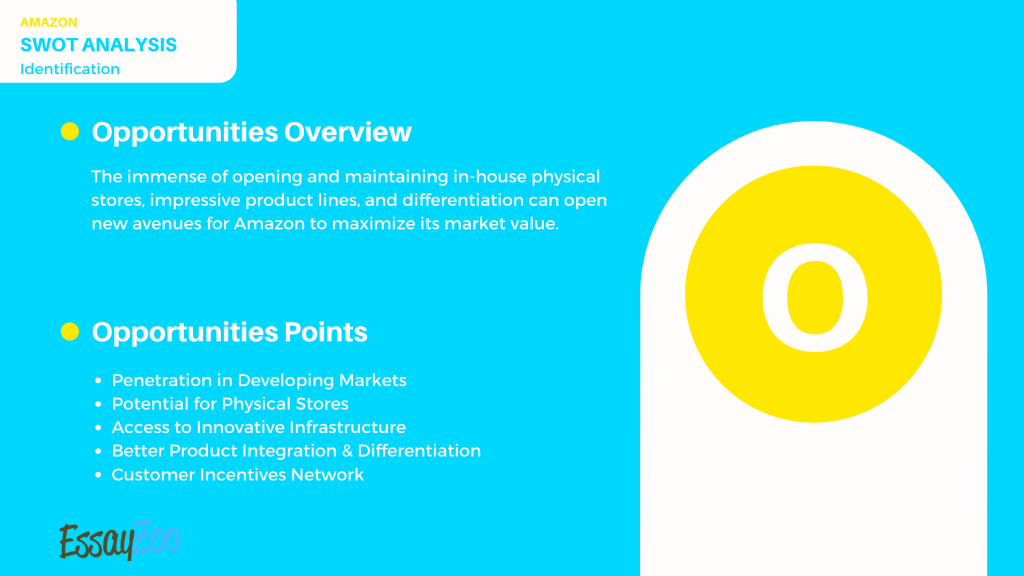
Penetration in Developing Market
With a vast and diverse network, Amazon does not have to face much opposition to penetrating new markets in developing countries.
Potential for Physical Stores
By opening new physical retail stores in key strategic locations along with online stores, Amazon can enhance its brand recognition and compete from an advantageous position with other key retailers. This will also minimize dependence on third party sellers.
Access to Innovative Infrastructure
Amazon has major gains in the online retail industry, but it is also gaining momentum in other fields. It is expanding in regions and markets by identifying the needs of the local customers. Amazon’s initiative to introduce electric rickshaws in India is a step like this. The brand is also in a better position to catch counterfeit goods and theft as well as product categories.
Better Product Integration & Differentiation
Amazon Prime Sale is often a highlight of the year when it comes to retail business, thanks to its vast network of premium subscribers. To cater to the needs of different consumers, Amazon is in a much better shape than any of its competitors to introduce product differentiation.
Customer Incentives Network
From established markets to emerging ones, Amazon can take great advantage of price discrimination by offering a wide array of price tags for different customers. Also, adopting cryptocurrency and other e-currency modes instead of the fiat one can lead to more market capture.
😨 Threats
Although Amazon is a retail Goliath, it is still humbled by many Davids, combined from controversies to competition in several markets. Here is a look at some of the threats for our SWOT Analysis of Amazon.
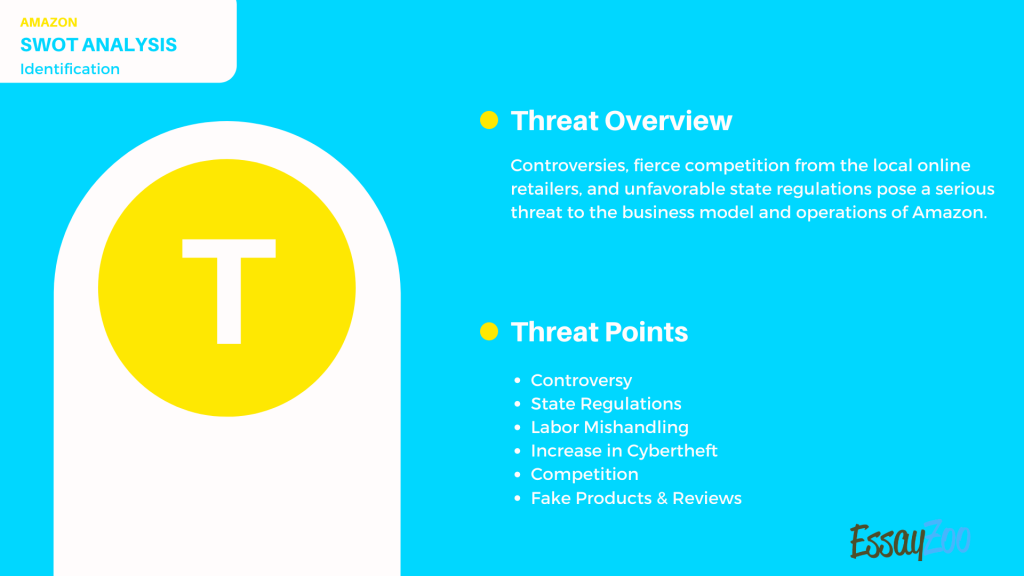
Controversy
Controversies have often marred the images of brands and Amazon is no exception in this case. In 2010, the company was seriously affected by protests when controversial books were found in its directory.
State Regulations
Many countries are antagonistic to Amazon’s company operations and business model, including Cuba, Iran, North Korea, etc. This can seriously affect the revenue volume overall.
Labor Mishandling
Amazon is experiencing a bad reputation when it comes to labor disputes. In many cases, the company was involved in labor abuse and mishandling which further worsened its image and brand identity.
Increase in Cybertheft
The rise of cybercrimes and poor security structure can lead to distrust from customers. It can also give rise to financial crimes and fraud.
Competition
Amazon has its fair share of market competition. Big retail brands such as Walmart, Target, eBay, and many more can severely damage their market hold. In its subsidiaries, it is facing competition from Netflix, Uber, Tesla, UPS, etc.
Fake Products & Reviews
Since Amazon cannot possibly test and vet each listed product in its directory, this lax security has allowed fake products and reviews to creep into the system. This is not only damaging to customer experience but also affects the brand’s name and integrity.
Amazon SWOT Table

Strengths
- 💪 Strong Brand Identity
- 💪 Brand Ranking
- 💪 Customer-Centric Company
- 💪 Innovative Ideas
- 💪 Cost Leadership
- 💪 Vast Inventory
- 💪 A Hybrid of Local & Global Practices
Weaknesses
- 🤒 Transparent Business Model
- 🤒 Marginalized Gains In New Markets
- 🤒 Poor Product Reception & Growth
- 🤒 Bad Reputation
- 🤒 Non-Existent Physical Stores
- 🤒 Tough Vetting & Testing Regimen
- 🤒 Dependence on Third Party Sellers & Employees
Opportunities
- 🤑 Penetration in Developing Markets
- 🤑 Potential for Physical Stores
- 🤑 Access to Innovative Infrastructure
- 🤑 Better Product Integration & Differentiation
- 🤑 Customer Incentives Network
Threats
- 😨 Controversy
- 😨 State Regulations
- 😨 Labor Mishandling
- 😨 Increase in Cybertheft
- 😨 Competition
- 😨 Fake Products & Reviews
Read Also:
- Airbnb SWOT Analysis
- Apple Company: SWOT Analysis
- Burger King SWOT Analysis In 2022
- Free Chick-fil-A SWOT Analysis
- Coca Cola SWOT 2022
- SWOT Analysis of Disney Company
- SWOT analysis for Dunkin Donuts’s company
- Strengths, Weaknesses, Opportunities, and Threats of Facebook
- SWOT Analysis of Google
- [2022] Johnson & Johnson SWOT Analysis
- SWOT Analysis for McDonalds – Free Example
- Netflix SWOT Analysis 2022
- SWOT Analysis: Nike
- Procter & Gamble: Strengths, Weaknesses, Opportunities, Threats
- Comprehensive SWOT Analysis of Samsung
- Swot Analysis of Starbucks’s Current Situation
- Informative SWOT Analysis of Tesla
- In-Depth SWOT Analysis of Toyota
- UPS SWOT Analysis Essay
- Strategic SWOT Analysis of Walmart
- Best SWOT Analysis of Zara
